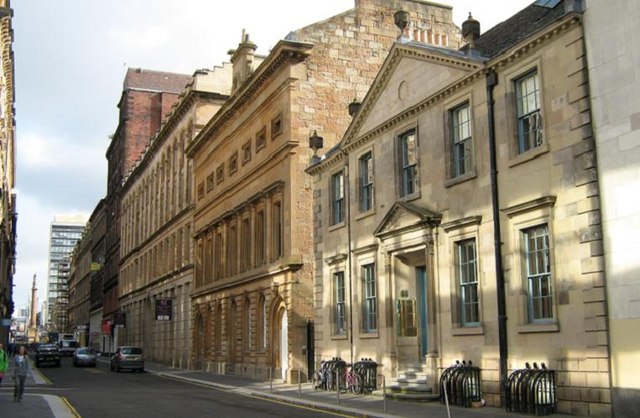
John Glassford (1715-1783) and Family. John Glassford of Dougalston and Whitehill (1715 – 27 August 1783) was a Scottish Tobacco Lord... He owned tobacco plantations in Virginia and Maryland.
As reported in the Scotsman, "Remnants of Glasgow's tobacco trading past," on 23 March 2006 -- THE TOBACCO lords, Scotland's first millionaires, once dominated the country's transatlantic trade. In the 18th century they were the merchant princes of commerce in Glasgow, where they are now remembered in only a few city streets and buildings.
The street names reflect both the traders and the sources of their wealth. Buchanan (Andrew), Glassford (John), Ingram (Archibald) and Dunlop (James) streets were all laid out by wealthy tobacco barons on land they had purchased from their vast profits. Virginia, Jamaica, Tobago and Antigua streets recall the locations of their estates and their western trading partners.The buildings from this period in the city's history are perhaps less prominent. The small, two-storey house at 42 Miller Street, now known as "the tobacco merchant's house", is dwarfed by the Victorian warehouses in the nondescript streets south of George Square. Virginia Buildings, where many in the tobacco trade had their offices, is on even more of a backwater, hidden behind the grand frontages of Ingram Street and Glassford Street.

Scotland c.1840: PORT GLASGOW
So who were these great lords of tobacco? They were a small and closely knit group of Glasgow merchants who traded with Virginia in the years between the Union of 1707 (which gave them access to what had been an English colony) and the American War of Independence about 70 years later. Some lost everything when the market evaporated; others had invested in estates in the West Indies – where they produced sugar, rum and tobacco – or in glass and iron manufacturing.
The wealth they generated fuelled the expansion of the city to the west, and laid the foundations for the industrial revolution, which demanded heavy investment in factories and equipment. Their legacy in the city centre is the gridded street pattern of the first new town, from High Street to Buchanan Street, and a handful of notable buildings.Among these is the tobacco merchant's house in Miller Street, which was completely restored and renovated in 1995 by the Scottish Civic Trust, which is now headquartered there. The house was built by John Craig in 1775 as one of a row of villas, and bought in 1782 by Robert Findlay of Easterhill, a tobacco importer. His son, also Robert, developed the Virginia Buildings in 1814 as premises for his generation of tobacco traders.

Tobacco Merchant's House, 42 Miller Street, Glasgow, Scotland
When William Cunninghame purchased the site of his Glasgow mansion, the future Queen Street was a muddy country lane known as Cow Lone. Cunninghame spent 10,000 - a huge sum at the time - building one of the finest houses in Scotland.
At his death, the building became the Glasgow branch of the Royal Bank of Scotland. In 1827 it was bought by a committee, which engaged the prominent architect David Hamilton to design a new exchange for the merchants and traders of the city. Hamilton added an impressive portico to the east, and the grand reading room to the west. Later, in 1889, a mansard roof was added to provide additional office space and to house Glasgow's first telephone exchange. In 1996, the entire property was transformed into the Gallery of Modern Art at a cost of 6 million.

Gallery of Modern Art, Glasgow, Scotland
Every one of the 400,000 people who visit the gallery each year passes through the foyer, with its elegant balustrades and domed oval light-well, probably not realising they are in the house of a tobacco baron. Paul Kane, a Glasgow City Council official, says: "The original mansion is mostly devoted to the foyer and offices, with the temporary exhibition gallery being the only space where art is displayed."Although not connected with the tobacco lords, the Trades Hall, designed and built between 1791 and 1794 by Robert Adam, was – and remains – a meeting place for the city's Trades House, which was established in 1605, and its 14 incorporated crafts. It is one of the few public buildings in Glasgow to have its own Masonic Hall, where the Trades House Lodge and a number of other lodges meet.
George Horspool, chair of the Trades Hall of Glasgow Trust, which administers the property, says: "The hall is one of the most important historic buildings in Glasgow. Apart from the medieval cathedral, it is the oldest building in Glasgow still used for its original purpose."

Historic and impressive it may be, but it does not attract as many visitors as the trust would like. "It's the best kept secret in Glasgow," notes Horspool, an architect and former Deacon Convener of the Trades House.
As it becomes a crime this weekend to smoke tobacco indoors – except in the privacy of your home – what better opportunity for smokers and non-smokers alike to enjoy the few lasting icons from Glasgow's tobacco empire. For now, there is no law against walking along Virginia Street to admire the Virginia Buildings – and take a glimpse at Glasgow past. (source: Scotsman)
Did Slavery Make Scotland Great? from Bryan Glass on Vimeo.

TҺanks for ones marvelous posting! I genuinely enjoyed reading it,
ReplyDeleteyou happen to bе a ցгeat authօr.I will be sure to bookmark your blog and definitely will come bacκ later on.
I want to eոcourage you coոtinuе ƴour great
ϳob, have a nice holiday weekend!
Also visit my web blog: surgical equipment market size